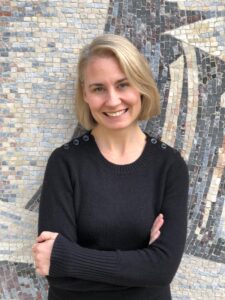What does democracy look like? Columns, marble, and colonnades usually come to mind when we try to visualize this particular political regime. Modern statehouses, courts, and capitol buildings generally follow a standard Greco-Roman design, and thus our conception of “democratic buildings” is formed by this persistent adaptation. But what about in antiquity, when the Athenians first tried to figure out what democracy even was? Can we identify a type of “democratic architecture” in Late Archaic Athens?
These are the sort of questions that I am most interested in. In the late 6th century B.C.E., the Athenians passed a series of reforms that would eventually result in the world’s first democracy. By attending to the years immediately after the reforms, my work considers how we can use monumental public buildings to understand better how the reforms were implemented, how the new government operated, and how it came to flourish.
One big part of this project is creating a catalogue of everything built in Athens and Attika between 508/7 – 480/79 B.C.E., particularly public and sacred buildings and major topographical modifications. This is a tricky endeavor because the vast majority of it was destroyed during the Persian invasion of 480. In total, though, I have been able to document over 40 monumental structures for this brief timespan, a massive output of financial, material, and labor resources. Such a heightened level of building activity can, in turn, tell us interesting things about the nascent political regime, such as the polis’ ability to harness these various resources. The distribution of many of these buildings on the borders of Athenian territory also speaks to the priorities of the city in the years just after the passage of the democratic reforms. It might not be possible to identify a particular structure as a “democratic building” or to create a canon of “democratic architecture,” but my research does demonstrate how architecture and political regime communicate with each other and how the built environment has the power to both help and hinder political flourishing.
Overall, my research is focused on these intersections, between architecture and politics, between communication and kinaesthetics, between change and continuity. It comes from a lifelong interest in how things fit together (due in part to my father, who was a carpenter). My archaeological fieldwork is also informed by these ideas, which have, in turn, shaped my research. In the Sanctuary of the Great Gods on Samothrace, for instance, director Bonna Wescoat has launched a research program rooted in experiential phenomenology, centered on how an ancient initiate would have experienced the sanctuary and the rituals, that I have been privileged to participate in for the past 7 years. At Contrada Mango (Segesta) in Sicily, I serve as field director for a small team led by Margaret M. Miles, where we have focused on issues of access and viewsheds. Participating in these projects has enriched my own research on ancient Athens and allowed me to think more broadly about the intersections of architecture, identity, and ritual practice. Being in Washington, D.C. this semester has provided even more fuel for the fire because the city itself is a living encapsulation of these different relationships, and of the role of architecture in democratic activity.
Jessica Paga
 Jessica Paga (PhD Princeton 2012) is an archaeologist and architectural historian who specializes in Greek architecture of the Archaic and Classical periods. She is currently an Assistant Professor in the Department of Classical Studies at William & Mary, prior to which she held an Andrew W. Mellon Post-Doctoral Fellowship in Modeling Interdisciplinary Inquiry at Washington University in St. Louis. Jess is a senior archaeologist with the American Excavations in the Sanctuary of the Great Gods on Samothrace, Greece, as well as field director for the Contrada Mango Project in Segesta, Sicily. While at the CHS, Jess will work on completing her book on monumental architecture in Athens and Attika during the early democratic period, and begin researching her next project on the relationship between architecture and politics in the pre-modern Mediterranean.
Jessica Paga (PhD Princeton 2012) is an archaeologist and architectural historian who specializes in Greek architecture of the Archaic and Classical periods. She is currently an Assistant Professor in the Department of Classical Studies at William & Mary, prior to which she held an Andrew W. Mellon Post-Doctoral Fellowship in Modeling Interdisciplinary Inquiry at Washington University in St. Louis. Jess is a senior archaeologist with the American Excavations in the Sanctuary of the Great Gods on Samothrace, Greece, as well as field director for the Contrada Mango Project in Segesta, Sicily. While at the CHS, Jess will work on completing her book on monumental architecture in Athens and Attika during the early democratic period, and begin researching her next project on the relationship between architecture and politics in the pre-modern Mediterranean.
